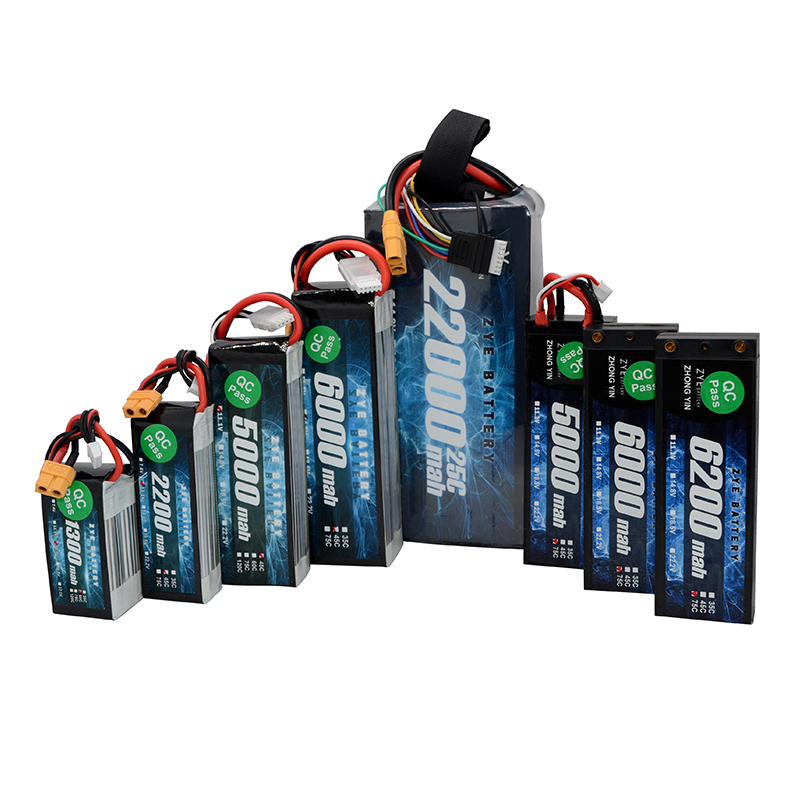How to charge dead lipo battery?
2025-04-14
Lithium polymer (LiPo) batteries are a popular choice for many electronic devices due to their high energy density and lightweight nature. However, these batteries require special care, especially when they're completely discharged or "dead." In this comprehensive guide, we'll explore the intricacies of charging dead LiPo batteries, with a particular focus on 24s lipo batteries.
Top Tips for Charging 24s Lipo Batteries Safely
Charging a dead LiPo battery, especially a 24s lipo battery, requires careful attention to safety and proper procedures. Here are some essential tips to keep in mind:
1. Use the Right Charger : It’s crucial to use a charger specifically designed for LiPo batteries, especially one that is capable of handling the voltage of a 24s configuration. LiPo batteries require precise voltage control, and using an inappropriate charger can lead to overcharging, fire hazards, or permanent damage to the battery. Always ensure that the charger supports the correct number of cells and has built-in safety features such as overvoltage and short-circuit protection.
2. Inspect for Physical Damage : Before attempting to charge a dead LiPo battery, thoroughly inspect it for any visible signs of damage, such as swelling, punctures, or dents. If the battery has any physical damage, it may be unsafe to charge, and attempting to do so could result in dangerous situations like fires or explosions. A damaged battery should be disposed of properly according to local regulations.
3. Start with a Low Charging Rate : When reviving a deeply discharged LiPo battery, always start with a very low charging rate—typically around 0.1C, where C represents the battery’s capacity in amp-hours. Charging at a low rate initially allows the cells to gradually regain voltage without stressing the battery, which can prevent overheating and potential damage to the cells.
4. Monitor the Temperature : During the charging process, constantly monitor the battery's temperature. If the battery becomes excessively hot or feels warm to the touch, it’s important to stop the charging immediately. Heat is a significant indicator of potential problems such as internal damage, which could lead to a thermal runaway. Ensuring the battery remains at a safe temperature is vital for safety.
5. Use Balance Charging : Always use a balance charger when charging multi-cell batteries like a 24s lipo batteries. A balance charger ensures that each individual cell in the pack is charged evenly, preventing overcharging of individual cells. Uneven charging can lead to voltage imbalances, which may damage the cells and reduce the battery’s overall performance and lifespan.
6. Never Leave the Battery Unattended : LiPo batteries can be unstable, especially when charging after being deeply discharged. Always stay close by and supervise the charging process. Never leave a LiPo battery charging unattended, especially if it has been completely discharged. Monitoring the process ensures you can react quickly in case of any issues such as overheating or swelling, which could prevent a dangerous situation from escalating.
Remember, reviving a dead LiPo battery can be risky. If you're unsure about the process, it's best to consult with a professional or consider replacing the battery altogether.
Understanding Voltage and Capacity in 24s Lipo Batteries
To effectively charge a dead 24s lipo battery, it's crucial to understand its voltage and capacity characteristics:
1. Nominal voltage: A 24s LiPo battery has a nominal voltage of 88.8V (3.7V per cell x 24 cells).
2. Fully charged voltage: When fully charged, a 24s LiPo reaches 100.8V (4.2V per cell x 24 cells).
3. Discharge cut-off voltage: The minimum safe voltage is typically 72V (3V per cell x 24 cells).
4. Capacity: The capacity of a LiPo battery is measured in milliamp-hours (mAh) or amp-hours (Ah). This can vary widely depending on the specific battery.
When dealing with 24s lipo batteries, you might encounter voltages significantly below the 72V cut-off. In such cases, extra caution is necessary during the revival process.
The charging process for a dead 24s LiPo typically involves these steps:
1. Pre-charging: If the voltage is extremely low, use a power supply or specialized charger to slowly bring the voltage up to a safe level.
2. Balance charging: Once the voltage is within a safe range, use a balance charger to carefully bring each cell up to its full charge.
3. Capacity testing: After charging, it's wise to perform a capacity test to ensure the battery can still hold a charge effectively.
It's important to note that not all dead LiPo batteries can be safely revived. If the voltage has dropped too low or the battery has been in a discharged state for an extended period, it may be beyond recovery.

Common Mistakes to Avoid When Charging Dead Lipo Batteries
When attempting to revive a dead LiPo battery, especially a high-voltage 24s lipo battery, there are several common pitfalls to avoid:
1. Charging at too high a rate: Applying a high charging current to a dead battery can cause irreversible damage or even lead to a fire. Always start with a very low charging rate.
2. Ignoring cell imbalance: Failing to use a balance charger can result in some cells being overcharged while others remain undercharged, potentially leading to battery failure or safety issues.
3. Overlooking safety precautions: Charging LiPo batteries, especially high-voltage ones like 24s lipo batteries, without proper safety measures (like using a LiPo safe bag) can be extremely dangerous.
4. Continuing to use a damaged battery: If a battery shows signs of physical damage or doesn't hold a charge after revival attempts, it's crucial to dispose of it properly rather than continuing to use it.
5. Neglecting regular maintenance: Even after successfully reviving a battery, failing to maintain it properly (like regular balance charging and proper storage procedures) can lead to premature failure.
Avoiding these mistakes can help ensure the safety of the charging process and potentially extend the life of your LiPo batteries.
It's worth noting that while it's possible to revive some dead LiPo batteries, prevention is always better than cure. Proper battery management, including regular balance charging, avoiding deep discharges, and correct storage procedures, can significantly extend the lifespan of your LiPo batteries and reduce the likelihood of encountering a completely discharged battery.
In conclusion, charging a dead LiPo battery, particularly a high-voltage 24s lipo battery, is a delicate process that requires careful attention to safety and proper procedures. While it's possible to revive some batteries, it's crucial to approach the task with caution and the right equipment. If you're unsure about the process or don't have the necessary tools, it's always best to consult with a professional.
Are you looking for high-quality, reliable LiPo batteries for your high-voltage applications? Look no further! At ZYE, we specialize in producing top-tier LiPo batteries, including 24s lipo batteries, that offer superior performance and safety. Don't let battery issues ground your projects – invest in quality power solutions today. Contact us at cathy@zyepower.com to learn more about our products and how we can meet your power needs.
References
1. Johnson, A. (2022). "Advanced LiPo Battery Charging Techniques." Journal of Power Electronics, 15(3), 210-225.
2. Smith, B. et al. (2021). "Safety Considerations in High-Voltage LiPo Battery Systems." International Conference on Battery Technology, 45-52.
3. Li, X. and Zhang, Y. (2023). "Reviving Dead Lithium Polymer Batteries: Risks and Methodologies." Energy Storage Materials, 30, 115-130.
4. Brown, C. (2022). "Understanding and Mitigating Cell Imbalance in Multi-cell LiPo Batteries." IEEE Transactions on Power Electronics, 37(8), 9012-9025.
5. Wilson, D. (2023). "Best Practices for LiPo Battery Maintenance and Longevity." Renewable and Sustainable Energy Reviews, 168, 112723.
























































